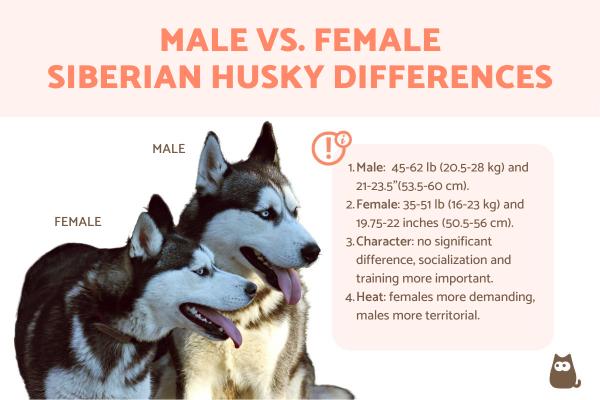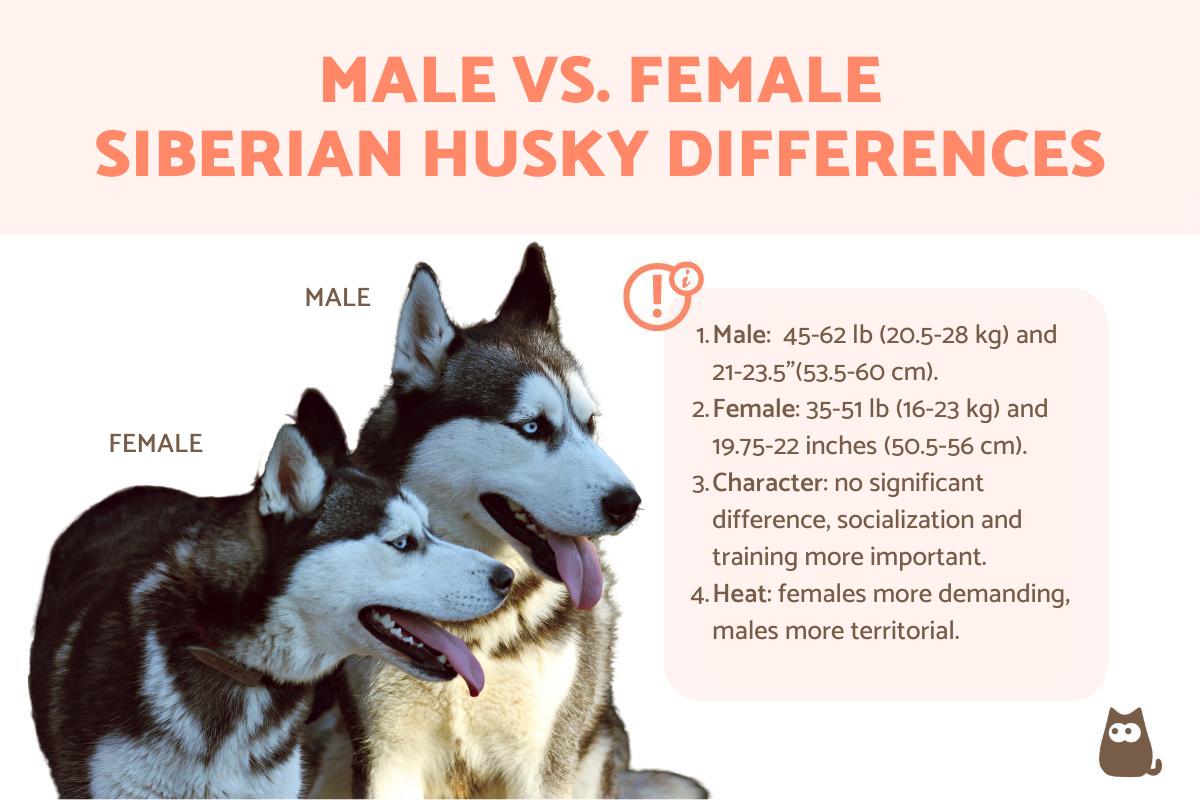Siberian Husky Male vs. Female Differences



Animal file: Siberian Husky
Whether male or female, the Siberian Husky has experienced a boom in popularity in recent years. Noted for their loyal personality as much as their wolf-like physical appearance, many prospective dog owners are considering adoption of a Husky into their family. Initially used as a working dog, they have become a wonderful companion to many types of family, but only if they are able to meet their specific needs in terms of care and other factors. Siberian Huskies require a lot of physical stimulation, but their high intelligence also means they need cognitive stimulation in the form of education and training. They are also sociable, but can be somewhat stubborn.
If you think you would like to adopt a Siberian husky into the family, it is important you consider everything you can before doing so. AnimalWised helps you make an educated decision with our article explaining the Siberian Husky male vs. female differences.
Size difference between male vs. female Siberian Husky
Many of us might think a Siberian Husky is a large dog, but they are considered medium sized. Despite having a robust body, their very thick and dense coat gives them the appearance of a larger dog. In reality, the breed standard indicates the Siberian Husky should not exceed 62 lb (28 kg) in weight. Another reason many think of the Husky as large is the fact they are often confused with the Alaskan Malamute, a large dog that can reach 88 lb (40 kg) in weight.
With this in mind, we take a look at the differences in weight and height between male and female Siberian Huskies:
- Male Siberian Husky: between 45-62 lb (20.5-28 kg). Regarding their height at the withers, males are larger and usually measure between 21-23.5"(53.5-60 cm).
- Female Siberian Husky: they are somewhat lighter, reaching weights measuring between 35-51 lb (16-23 kg). They measure between 19.75-22 inches (50.5-56 cm) in height.
The weights and heights of huskies can vary depending on their genetic line. For example, some breeders may focus more on obtaining stronger and larger working animals while others may choose to breed more slender and lighter dogs. In any case, the important thing is to always keep the animal within a healthy weight range, paying special attention to avoiding obesity problems.
In addition to weight, you can learn more about the differences between the Siberian Husky and Alaskan Malamute with our related article.

Male and female Siberian Husky character
The character of a dog depends on a large number of factors among which sex is not very relevant. There is no evidence that there are major differences between the temperament of a male Husky vs. a female Husky. The fact that a dog has a personality which is more or less affectionate, obedient, calm, sociable, tolerant or any other trait is a consequence of many factors, not solely genetics, of which breed is an important element.
The environment in which a dog develops, the care they receive, their education level and general experiences will play a more significant part in shaping their personality. In terms of character, choosing a male or female Siberian Husky will depend on the individual, not their sex. Much more important is providing the right level of training, socializing from a young age, using positive reinforcement and meeting all of their physical, social and emotional needs.
General temperament of the Siberian Husky
While breed is not the most important determining factor in terms of temperament, there are some general character traits which are more common in Huskies. Generally speaking, they tend to be friendly, sociable and tolerant dogs. They are especially good with other animals and children, as long as they have been appropriately socialized.
Physically, Huskies have a very high energy level and require constant stimulation and regular exercise. They can be quite noisy, but are also attentive and very vigilant dogs, being protective over their human family. Although not aggressive, they can be somewhat distrustful of strangers. Due to a potential for stubbornness, they can be a challenge to some when training, but will respond well if their education needs are met adequately.
Taking these factors into account, we cannot see much significant difference between female vs. male Siberian Huskies. In terms of practical care, they also have the same needs when it comes to grooming. You can learn more with out article which explains whether Siberian Huskies shed.
Other differences between male and female husky
Although sex in itself is not capable of justifying significant differences when it comes to the character of huskies, there are a series of behaviors that can differ between males and female dogs in general. Among the most important in terms of behaviors that influence the care we provide are those related to hormones. The dog's reproductive systems will influence behaviors which can differ between sexes in the following ways:
- Females: female sex hormones (estrogen and progesterone) are responsible for the appearance of heat in dogs. Also known as their estrus cycle, this is a period during which they may undergo behavioral changes. The instinct to look for a male to mate can cause female huskies to become more escapist, attention-seeking or even display threatening behavior, especially toward other dogs.
- Males: similarly, testosterone in males can cause them to behave more territorially, marking different spots in the house with urine or developing aggressive behavior. This is especially directed towards other males.
Spaying and neutering dogs is the best way to reduce these disruptive behaviors which are influenced by their reproductive hormones. Not only will this benefit guardians, but it will prevent the dog from experiencing frustration, aggression and other negative emotions which can be influenced by them. Neutering also reduces the risk of various diseases in both males and females, the reason why neutered dogs tends to have a longer life expectancy.
It is true that females may be slightly more costly than males. The spaying procedure itself is more invasive and consequently more expensive. Unspayed females will also have a much greater chance of developing certain diseases. Chances of developing uterine cancers or pyometra are reduced to zero if the procedure is successful. This doesn't mean male dogs won't also accrue expensive veterinary bills if they develop a disease, regardless if it is related to reproduction.
If you are unsure about what to do in terms of sterilization, you can read our related article on what is the best age to neuter a dog?

Should I adopt a male or female Siberian Husky?
After knowing the main differences between male and female Huskies, it is time to choose which sex best suits your lifestyle and living arrangements. As we have already mentioned, beyond size and some behavioral differences, there are no major distinctions between a male vs. female Siberian Husky in terms of how they will adapt to your home. What is much more important is how you are able to adapt to the dog.
For example, it is possible you already have dogs in the home. Some dogs may react differently to male or female dogs. This will be an important factor in determining which sex to adopt.
Before making the decision over which Husky to adopt, we recommend ask those responsible for the animals (shelter workers, previous guardians, etc.) about their individual temperament, habits and previous experiences. This will give you a better idea of the animal's character and how they will fit into your life, regardless of whether they are male or female.
Learn more about the responsibilities you need to meet as a guardian with our article on how to care for a Siberian Husky.

If you want to read similar articles to Siberian Husky Male vs. Female Differences, we recommend you visit our Comparisons category.







